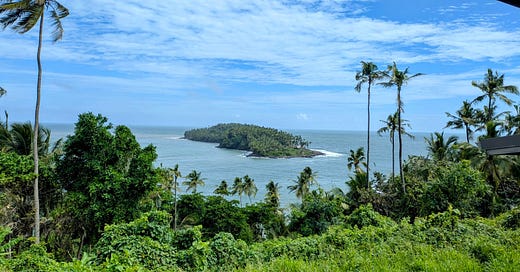I lost a toenail to French Guiana
Crêpes! Rosé! Carrefour! We've gone on holiday to France by mistake.
It was disconcerting when, one morning in February, Dave and I woke up in Europe once again. From Manaus in northern Brazil (where we took our recent Amazon boat tour), it made sense to continue down river towards the Guyanas, starting with the French one. And now, after a couple of buses and two long boat journeys, we suddenly found ourselves not only in the northern hemisphere but in France, of all places.
Broadly speaking, there’s just not much tourist information out there for French Guiana, at least in the English language sphere. I believe nervous French holidaymakers come here so that they can still speak French, use the Euro and shop in Carrefour, but otherwise I think there’s a fair assumption that backpackers wanting to see Latin America don’t tend to bother stopping, because it is, to all intents and purposes, France.
France! It doesn’t even count as a new country for my passport! I did know this, I am fairly sure. But I didn’t fully digest it until I arrived in Cayenne, looked around me and saw… Normandy? The same font and style of road signs. The same post-war architecture and aluminium roofs, albeit with tropical plants sneaking into the cracks at any opportunity. There are boulangeries, there are Carrefours-a-plenty, and they’re even stocked with French vegetables shipped from France for goodness sake.
There were plenty of welcome aspects to this, it should be noted: decent hot showers and flushing toilets (I had to double check with our Airbnb host that the rumours were true, we really could flush toilet paper down the bog); patisseries on every corner selling croissants and jambon-buerre; Orangina! But on the flipside, as the southernmost outpost of the European Union, French Guiana is shockingly expensive – to eat in, to travel around, to stay, to buy vegetables... I’m talking €12.90 for a small punnet of mushrooms (we didn’t buy them). The only thing that felt affordable was the wine – all French, naturellement, a big silver lining – so we existed largely on rosé, brie and baguettes for much of our whip around the country. Lovely, but after seven days of it my internal organs were complaining.

Inflationary veg prices in mind, Dave and I made a plan for efficiency: two nights in Cayenne, three in Kourou, and two in Saint Laurent Du Maroni. It went against our entire travel ethos so far in South America, but for one week only our purpose was to get through French Guiana swiftly, without forgoing the major sights but hopefully without bankrupting ourselves either. I feared this would be a difficult ask, however, upon discovery of the fact our first leg of transport into the country (a seat in a shared minivan to Cayenne) would cost us €50 each.
This is one of the biggest challenges in French Guiana: a real lack of public transport. After bundling ourselves into the country from across the water in Brazil via canoe (to the cost of about £3.50 each), the only way onwards to Cayenne was to join the Mercedes minivan racket. Patrick from SL Transports was our guy: fluent in French, English and Portuguese, he wore neon pink shorts and a baller attitude – as perhaps one would when earning €800 for each three-hour working day. Like all French Guiana drivers, I believe he spent the rest of his day in the gym.
The journey may have been expensive (consider that our recent two-day boat ride out of Manaus cost us £20 each) but Patrick provided a very efficient service, to be fair to him, cutting what should have been a three-hour drive down to two (help, my stomach). To the irritation of our fellow passengers he also very obligingly stopped by the French immigration office for Dave and I, a few miles out of the border town. I don’t think anyone else doing the journey normally bothers with such formalities, and the French border guards were a bit bemused to see us.
Patrick dropped us at the door of our Airbnb outside Cayenne – the first and last time we’d enjoy such a convenience – and for the first time in four days we lay down on a real bed, exhausted. We were staying with Vincent, who had moved with his family from Brittany in mainland France a few years previously to enjoy the warmer weather and regular campervan adventures across the South American continent. He was super kind and accommodating, if a little perplexed when I asked him if he knew the local bus timetable.
Everyone with money in French Guiana drives a Peugeot or a Renault (unless they’re part of the Mercedes taxi-van mafia) and those who don’t have a car tend to hitchhike. It means catching a ride is easy enough, in theory – plenty of people driving past will offer a lift into town for a mystery fee – but we were determined to crack Cayenne’s elusive bus network. I just couldn’t bring myself to accept that public transport wasn’t a viable option in French Guiana, despite what we’d read about the place. And we did manage to catch one bus going into the city centre on our first day, but getting back again that evening was a washout.

Buses stop running early in Cayenne. Despite finishing dinner at the positively geriatric hour of 7pm, Dave and I left our restaurant to find the city centre deserted and the last transport out of town long gone. Flashbacks to missing the last bus home from Ipswich to Trimley at 10.30pm on a Friday night in the late noughties. Except this time I couldn’t ask a friend to let me sleep on their sofa. We spent a while investigating street corners for the ghosts of taxi ranks, but soon resigned ourselves to walking the 7km back to Vincent’s along Cayenne’s very unforgiving main roads.
During the seven days we spent in French Guiana, I averaged a daily step count of almost 25,000. Dave and I are used to walking long distances, and it’s been noted that we are fast-paced and lanky of leg. But in the strong equatorial sunshine, thick humidity and frequent tropical downpours, it was a lot, even for us.
One evening in Kourou as we staggered back into our Airbnb (a barely converted garage containing a futon bed) I peeled off my soaking shoes and socks and off with them came a full toenail. We’d walked all the way out to see the European space centre which is based there outside the town – very cool, yes, but it had monsooned the whole way and my trusty North Face hiking shoes could hack the pressure no longer. My toenail had been taken as collateral.
Still, I bandaged up my sad and tender little stub with plasters and we continued, walking the length of each strange town we came to – out of necessity and a dogged sense of duty to SEE the country, dammit, even if it didn’t feel like it wanted us to, at times.
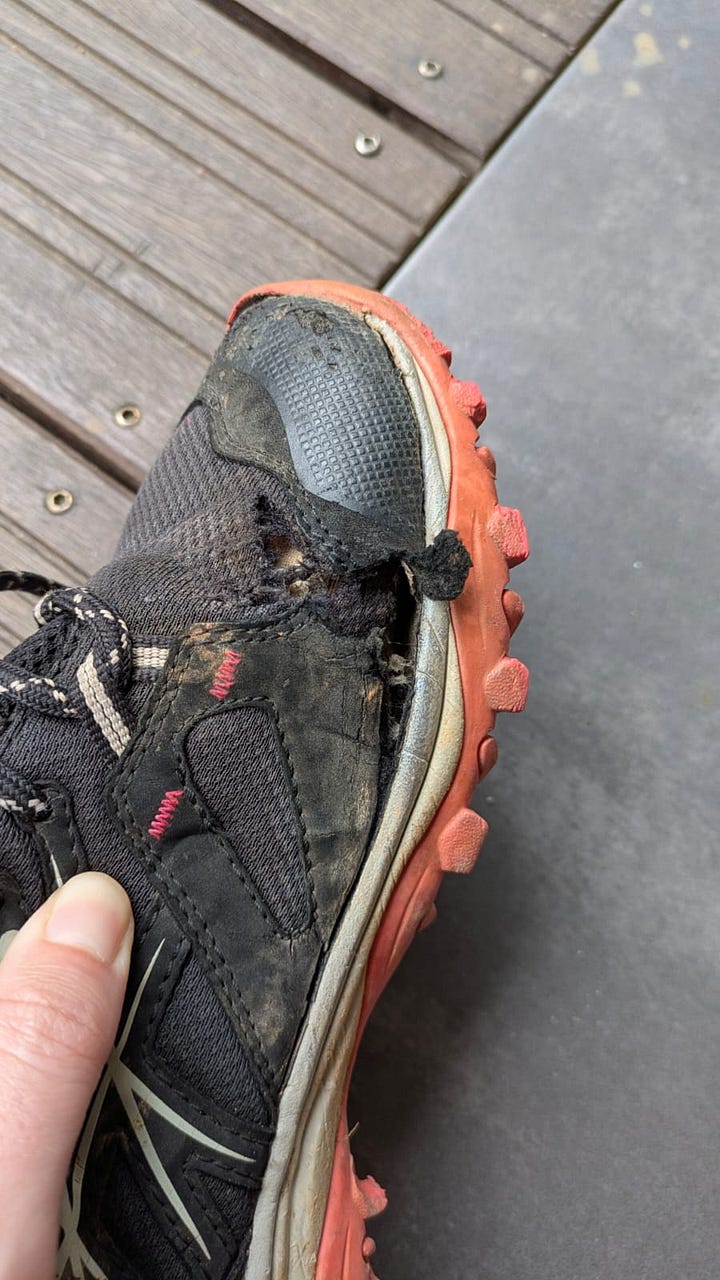
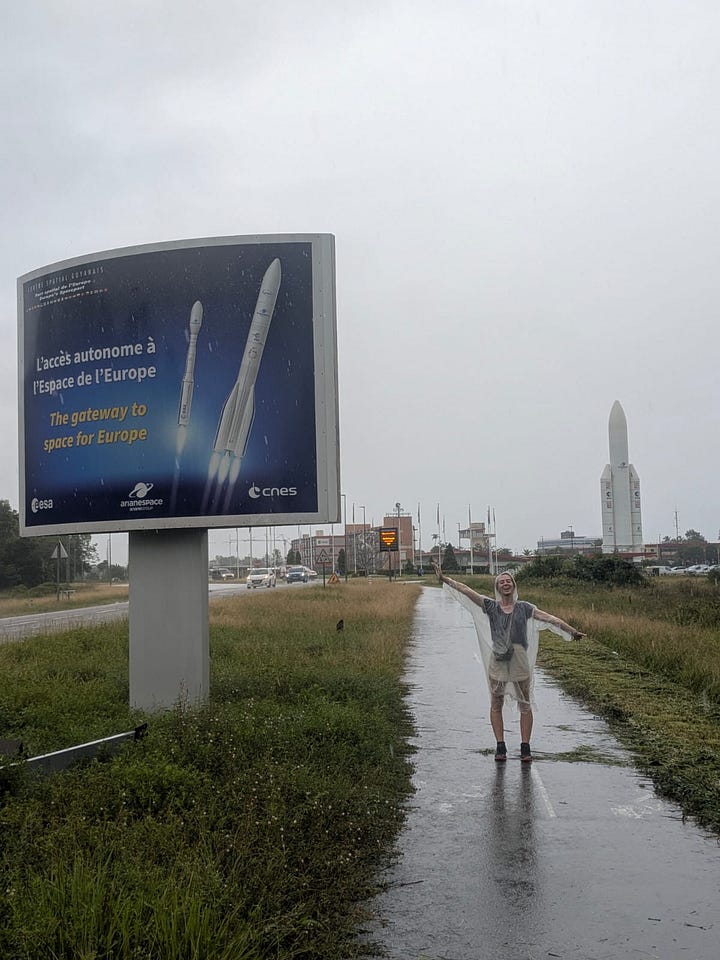
I didn’t love Cayenne. The city centre has its charms – namely the colourful, colonial-era wooden buildings – but was otherwise lacking in sights or activities. That’s ok: I don’t need to be busy all the time, and we spent an easy couple of hours on the terrace of Bar des Palmistes enjoying reasonably-priced rosé. But for a capital city it was eerily quiet. We waited for the Musée Alexandre-Franconie to open after its three-hour lunch break, only to discover that the listed hours were meaningless and nobody was coming back after lunch after all. The building was closed for the foreseeable, someone told us.
A trip to the Museum of Guyanese Cultures provided an interesting 20 minutes and we walked up a small hill to see a view of not a lot, but after that we’d pretty much exhausted the French Guianese capital of its tourist sights. It’s telling that Bar des Palmistes, which was nice enough but not a lot to write home about, is listed as not only one of the top places to go in Cayenne but in the whole of French Guiana according to the Lonely Planet guidebook. I can only imagine that the author of that particular section was plied with a fair few drinks on the house during their visit.
From Cayenne, we planned to continue west to Kourou, a smaller coastal town that exists largely for the European Spaceport located just outside it. It is also a stepping off point for visiting the infamous Salvation Islands (Îles du Salut), which were used as a penal colony for France’s most dangerous criminals during the 19th and 20th centuries.
Once again, I was determined to make our journey by bus: I knew a route existed, because I’d seen it printed on an actual bus in Cayenne’s centre and I’d stopped to ask the driver for the timetable. But when Dave and I arrived at the bus stop at the designated hour the following day, we were told the bus didn’t stop by Kourou after all. I pointed helplessly to the writing on the side of the bus that said “Cayenne - Kourou – St Laurent” but the driver was insistent and wouldn’t let us board. He showed us to the street corner where a group of car-share guys were gathered – a recognisable clique of gym bunnies stood waiting to fill their Peugeots for twice the price of the bus – and we had little choice but to join them.
I found Kourou more likable than Cayenne, but it's still a strange place. Walking around it felt eerily like being on an army base, or witnessing a cult – big groups of tall, northern European people running in matching uniforms down the road and colonising the public outdoor gym facilities at all hours. Those who weren’t in running gear tended to be wearing suits with lanyards and the lost expressions of people who had been flown in for a few hours to discuss science funding. And then there were the non-Europeans, locals working in hospitality, who clearly hated us.
One afternoon while attempting to plan the move from Kourou onto our next destination, Saint Laurent, Dave and I arrived at the point on the map marked “tourist office” just in time to see the two people working inside scurry away from us, heads down and into their cars. Another trip out to ambush them the next morning left Dave with one-word responses and the flat denial that a bus existed. But we'd seen it with our own eyes, he argued. Ultimately the answer was no, they couldn’t share a bus timetable with us out of Kourou. Neither could our Airbnb host, nor the lady working in the petrol station near the alleged bus stop, nor the local men drinking outside it who looked like they knew exactly what went on in this town. We'd already tried the city hall, the Super-U supermarket (which seemed to be the centre of most the town's activities) and the deepest recesses of the internet.
I remained determined. On the morning of our check-out, we headed to the Super-U with our bags just in time to see a bus stop outside it, allegedly going back to Cayenne – the one we’d not been allowed to board before. We waited some more. I went inside to buy dog food for the sad looking pregnant stray sat by us and picked up some cardboard to use as a hitchhiking prompt, really completing our homeless aesthetic.
After an hour, Dave got a response from one of the car-share lads we'd contacted as a backup – they had a minivan leaving for Saint Laurent that afternoon from a petrol station some way out of town. It felt like defeat, but the midday sun was hotter than hell and the possibility of getting stuck in Kourou for another night could cost us serious Euros. Even the bloody dog had disappeared and left me with two unopened tins of dog food.
Frothing with frustration at the obscurity of French Guianese travel, I stubbornly refused to pay the extra €20 fee to get picked up from where we were, so I scribbled the name of the petrol station on my cardboard and made a deal with Dave that we'd wait no more than 10 minutes for a lift. Luckily for my ego, a van stopped for us after approximately eight seconds and a French surfer called Shaun drove us straight to the petrol station (aka, the minivan pick-up point). Shaun hated Kourou because it was full of people like him and the surf was too shallow. He missed the days before Airbnb when Couchsurfing was for people who really wanted to embark on cultural exchanges and weren't just after a free bed. We nodded solemnly and thanked him for the free ride.
The first minivan failed to materialise, so we sheltered at an incongruous roadside sushi restaurant, and after some more frantic WhatsApping we eventually had another ride booked onto Saint Laurent. Of course this one was departing from the Super-U, where we'd started our day, but the driver, Matteus, was kind enough to come and rescue us from our motorway quarantine. An hour of rattling around Kourou followed, during which time we picked up more passengers and waited for one of them to wake up and pack her bags. But then we were on our way.
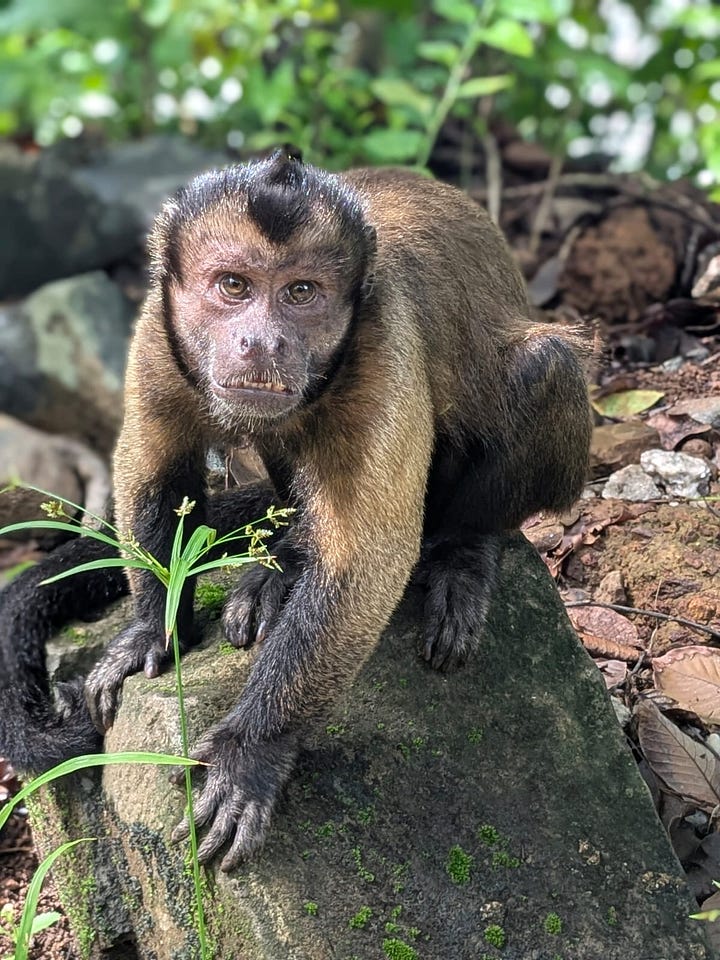
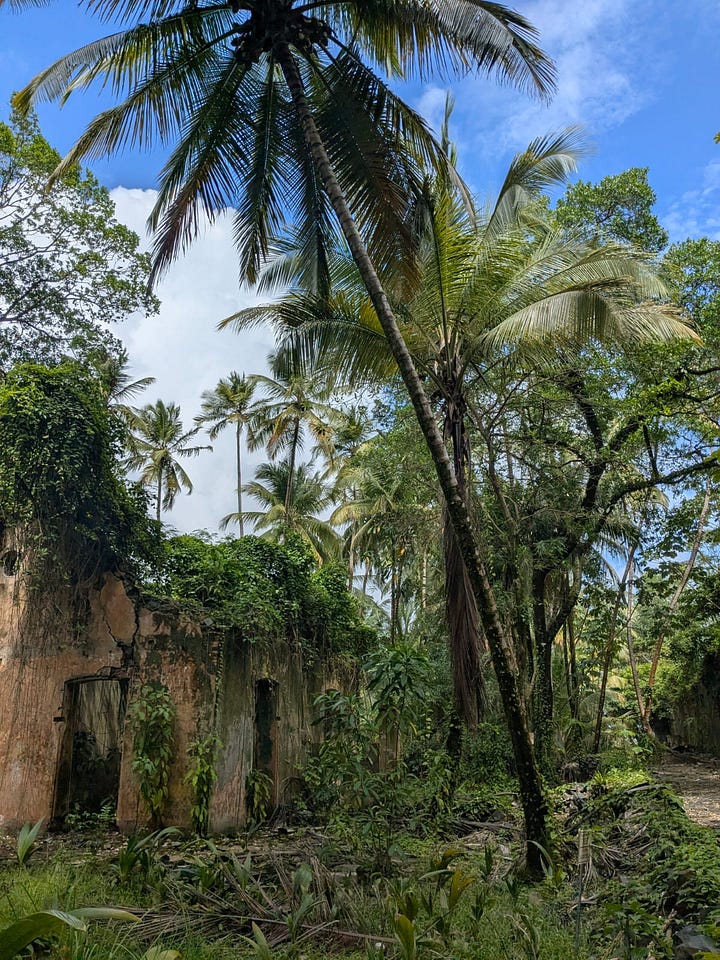
Twenty minutes down the road, we stopped again for a Brazilian passenger to call her friend. A group of lads in a Renault sped up to meet us with five enormous, empty plastic containers for her, which the driver clearly didn’t find weird or else he was very chill about it. The containers were loaded into the van and we continued west.
Sometime later, the Brazilian lady asked the driver to stop so she could pick up some beers. He obliged, but the van protested – and a few metres down the road its engine packed up for good. Well into her second can by this point, the Brazilian helped the driver pop the bonnet and called up the Renault lads again on Facetime to see if the between them all they could figure out the problem. Eventually she wandered off to take a bathroom break in the middle of the road and I could tell that any hope of rescuing the situation was dwindling.
By some miracle, long-suffering Matteus managed to flag down another minivan heading to Saint Laurent with just about enough seats for the rest of us. We left him to it, feeling guilty about the cash he wouldn't be getting for the miles travelled so far and already nostalgic for his air conditioning. A bumpy couple of hours later, Dave and I were unceremoniously dumped in a carpark in Saint Laurent, and from there we walked a slow, final 3km to our accommodation.
My feeling on it after a week in French Guiana, is that locals don't always see public services as something ‘for’ tourists – they wanted us to spend our tourist Euros elsewhere, and more of them than we would for the elusive public bus service. Maybe that’s fair enough – I’m sure most tourists who come over from France have more cash to spare than most French Guianese locals. But it certainly makes travelling through the country difficult for backpackers, or people who don’t have the means to hire a car – and that’s creates a negative cycle for tourism.
In any case, the truth is that French Guiana doesn’t need to pander to its tourists because it doesn’t really need us. The country’s main source of income comes from mining its substantial mineral resources (gold, iron, bauxite and diamonds), not to mention the Amazon Rainforest, which covers 95 per cent of the country. We European visitors are but tiny specks in the French Guianese economy – and it’s a similar story across the wider Guianese region.
So was it all worth it, I hear you cry? Probably, yes, I think so! French Guiana is a beautiful country and has some really interesting history. We enjoyed one of the best day trips we’ve had during our whole South American trip when we visited the Îles du Salut. They’re a group of three islands just off the coast from Kourou that were used as a French penal colony between 1852 and 1953, the most famous one being Devil’s Island, where Henri Charrière, aka “Papillion”, and Alfred Dreyfus – of Dreyfus Affair fame – were held prisoner.
In brief, Dreyfus was a French army officer who was wrongly convicted of being a German spy due to antisemitism. There was a film released about it in 2019 (An Officer and a Spy) and Dave says the book (The Dreyfus Affair) is very good. Charrière also became famous for his memoir (Papillion) about his time living as a prisoner on the island, but while Dreyfus was eventually pardoned and released from the prison, Papillion managed to escape.
These days the islands’ main inhabitants are several troops of monkeys, who are a fun if slightly intimidating presence, as well as trillions of leaf-cutter ants all forming a road around Saint-Joseph Island, which we became a bit obsessed with. We sailed by Devil’s Island to see the hut where Dreyfus was kept and enjoyed an appearance from some dolphins, but the island itself is out of bounds for visitors. We were allowed to roam around Île Royal, the largest of the three islands, where we even took a dip in the sea with the turles, and later we swam out to see the spooky ruins left on Saint-Joseph Island, which have mostly been overtaken by jungle since French law enforcement abandoned them in the 50s.
Île Royale has been better maintained, with some of the original buildings now open as a sort of low-key museum for visitors. You can even stay there, which we thought might be fun – especially when we read about an option to bring hammocks and sleep in a more basic room (prison cell??) for not many Euros. Except the Tripadvisor reviews made it sound as if the staff might try and kill us, which quickly put us off (one person commented that the prisoners were probably treated better than today’s guests, which made me lol but now I can’t find it…).
In any case, riding around on the catamaran was awesome fun, with good hosts who kept the cocktails flowing. Dave and I befriended a French girl and her mum who lived in Guadeloupe and luckily for us spoke excellent English and could translate.
Back on land, I enjoyed L’Antidote Wine Cave on Kourou’s seafront very much – for the wine and for eavesdropping on the space nerds gathered there. As an amateur space nerd myself, I’d been very excited at the prospect of visiting the space centre in French Guiana, and the museum was good – worth the hour-long trek out there in the rain. We were given a tour of the rockets and a crash course in their design and history by one of the staff, and we enjoyed the many interactive drawing and lego stations that were definitely designed for children. We also learned that basically anyone can send a satellite into space via the European Space Agency there in Kourou, but they will vet you to make sure it’s legitimate and you do need several million dollars, charged by the gram. Elon Musk might do it cheaper, she noted, but the ESA’s rockets have far less tendency to explode.
We enjoyed ourselves hugely, but it’s probably much better if you can time your visit to the Kourou space station to see one of their actual rocket launches, which are held sporadically through the year and are free to attend if you book in advance. Unfortunately for us there wasn’t a launch planned for a few weeks, so maybe that’s a reason to return to the French Guiana one day in the future. When I’m rich, that is. Or better yet, if someone else is paying.
Travel bits and tips from this week
After a short canoe ride across the river from Brazil, we took a shared minivan on to Cayenne. Patrick from SL Transfers was great and stopped at the French border station for us.
Once in Cayenne we stayed in this Airbnb (a room in a family home; very comfortable and private)…
In Kourou we stayed in this Airbnb (fine; basically a fold out bed in a yoga teacher’s garage)…
And in Saint Laurent we stayed in this Airbnb (a fair way out of town; the most affordable thing we could find that didn’t make me scared).
We made ourselves baguettes and did a lot more cooking than normal simply because eating out in FG is pricey. But on our first night in Cayenne we had a very serviceable pizza from the excellently named Pizz’Amazone near our accommodation. The following day we stuffed ourselves with pastries and breaded goods from Boulangerie Bousaid and enjoyed a few drinks at Bar des Palmistes. Later, we had a good value meal at Deli Oriental near the central market.
In Kourou we liked the DeliFrance café and L’Antidote wine bar on the seafront. We had a pleasant chicken curry and pasta at Le P’tit Café (only open Tues-Fri, which really cracks me up) and another good pan-Asian meal at Restaurant La Tulipe. And then an unexpectedly great Asian buffet at Sushi bar de Kourou while waiting for a lift to Saint Laurent.
Our Îles du Salut tour from Kourou was run by Tropic Alizes and it was great! We booked it very last minute and they had a space for us, but we know people who weren’t so lucky. Like most things in FG it’s better to book ahead if you can.
In Saint Laurent we mostly cooked, but we got our tastebuds going for Suriname with a delicious lunchtime roti and curry at the central market (Marché de Saint Laurent, Wednesdays and Saturdays).
On the off chance you’re reading this because you’re travelling to French Guiana soon, get in touch and I can share all my taxi lads’ numbers and some other practical tips for getting around. Trust me, you might need them.

